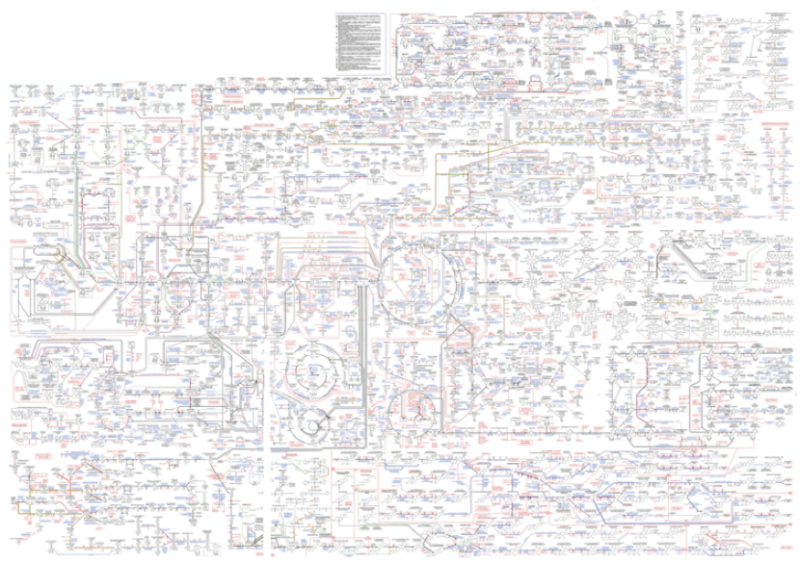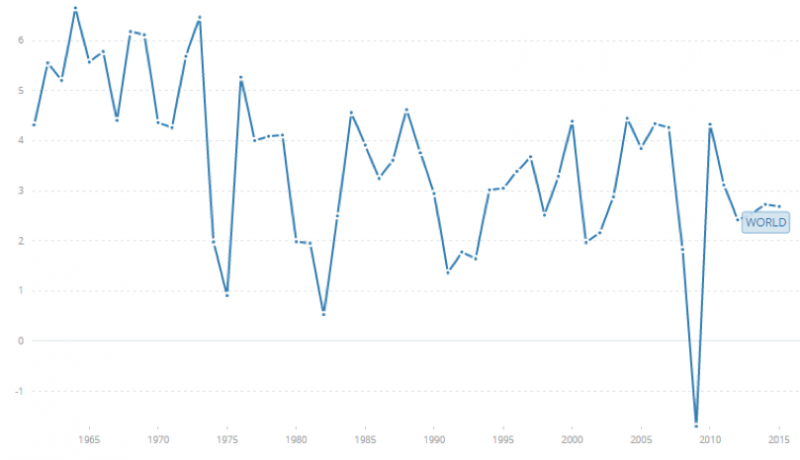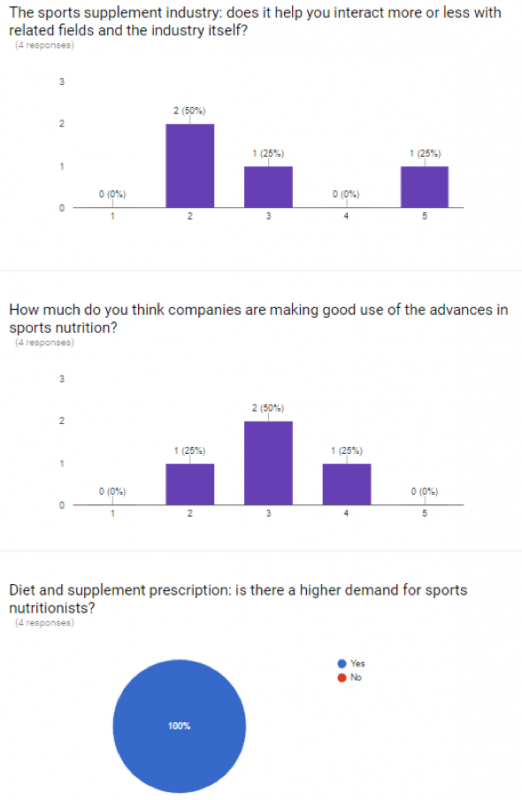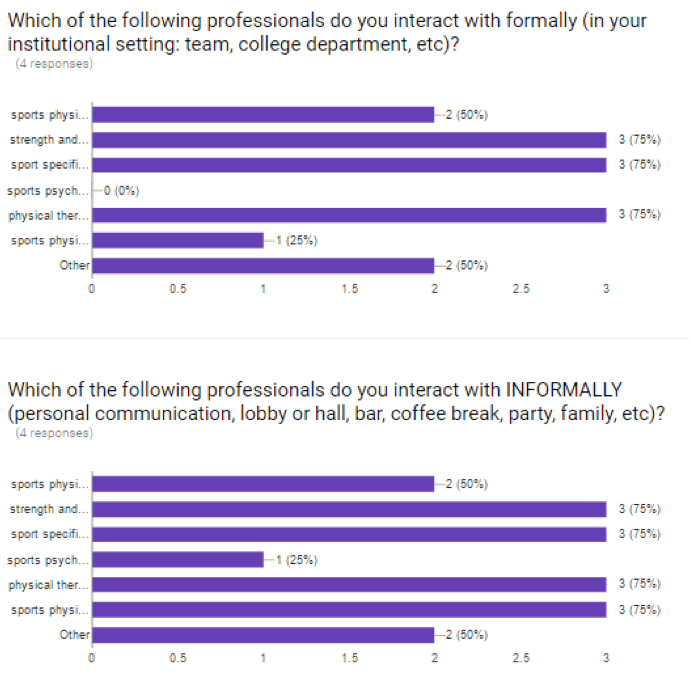Talking about a scientific discipline or professional field requires that we know its object. It also requires us to know where it came from. Do you know what sports nutrition is? Do you know what sports nutritionists or dietitians do?
There are several approaches to the history of any cultural endeavor, whether a scientific discipline, sport, or even political organization. In historiography, it is assumed that a certain subject, study object, or even the awareness about a certain phenomenon may be traced back to antiquity. It doesn’t mean, however, that what we mean, for example, as “nutrition sciences” or “the nutritionist/dietitian” has always existed.
While the history of human awareness about the relationship between food and health is fascinating and ancient, as food and herbs were the first sources of medication, nutrition sciences are quite recent. Sports nutrition, even more.
PART 1: All Together Now — Meet the Disciplines and Our Hosts
The study of disciplinary interactions (whether friendly, as in multi-, inter- or trans-disciplinary activity, or hostile, as one disqualifying and taking over the adversary discipline’s institutional space) requires the ability to discern and frame the discipline. That can only be accomplished if that scientific discipline is institutionalized, meaning it has:
- Its own communication and interaction channels (journals, meetings)
- Academic and research organization (departments, institutes, centers)
- College tracks or graduate degrees
- Professional regulatory mechanisms, such as certifications and licenses (when it is an applied field)
- Academic or professional associations.
When any or all of these items emerge in history is when that discipline can be said to have carved itself a space in society.
We have abundant examples in the movement related fields. Physical therapy was a dream pursued by a small marginal group of physicians until World War II poured mutilated and movement-impaired individuals by the thousands back into the country and made it a priority to recover them. Physical therapy came of age almost instantly.
Nutrition sciences didn’t even exist as such, being just a sub-branch of physiology until cardiovascular disorders, diabetes, and cancer were finally understood as being highly associated with food habits. Nutrition sciences not only came of age but were promoted to first line preventive medicine. Research into those fields grew under heavily funded projects during the 1980s and 1990s. The major historical marker, though, is the World Health Organization’s “Global Action on Nutrition and Exercise”, officially announced and published on May 4, 2004.
As for sports nutrition, it didn’t escape the trend of the “war push.” There is “market push” and there is “war push”, and the latter is faster and much more intense. Knowledge in general, science and technology in particular, are either “pulled” by internal forces in the pursuit of more knowledge by those who make it, or it is “pushed” by some force external to the scientists/specialists’ communities. We usually refer to it as “market push.” But war acts faster, more intensely, and is highly associated with the market.
During the Cold War, while physical therapy was dealing with the war burden and the new polio epidemics, sports sciences became a tool in the conflict between the two major world powers. The Olympic games, fulfilling its prophecy of being a theater to enact war “peacefully”, became the sports face of the Cold War: the Olympic war. No wonder great advances in sports nutrition and pharmacology were made then.
Like all other sports and exercise-related fields, the contributions from sports nutrition spill out to other health subjects and beg new questions. One example is the benefit of creatine supplementation for individuals on a vegetarian diet for cognitive function, or BCAA supplementation in cancer (Rae et al 2003, Wu et al 2015, Imanaka et al 2016). A more abstract contribution is the concept of performance itself. As the more affluent segments of our society get older, they want to “perform better.” Sports nutrition became a field closely related to healthy aging and enhanced professional performance.
This article relies both on a bird’s eye-view of the scientific discipline itself, with some history to make sense of the information, and on the input of people who actually use this knowledge on a day-to-day basis. In this series, we have one “host”—someone who will guide us through the practice of that field as a practitioner—and a few professionals that are consulted through an anonymous survey, since they may not be able or willing to identify themselves. In this chapter, our host is David Stache, working out of London, England. David has a Bachelor of Science in Sport, Health, Exercise, and Nutrition, and a Master of Science in Management. He has been working as performance nutritionist with several professional sports teams and individual athletes, from basketball to fighting.
From the survey, the only person who chose to identify himself was Dr. Tim N Ziegenfuss, presently CEO for The Center for Applied Health Sciences and former president of the International Society of Sports Nutrition.
Nutrition Science and Sports Nutrition
The University of Massachusetts Amherst School of Public Health and Health sciences built a simplified timeline of nutrition sciences that shows with facts what was meant earlier by “war push." The kick-off in the institutionalization of nutrition as a science happened during and right after World War II.
Food has always been a component in international conflict and the great advancement of agricultural sciences based on the input from organic chemistry (herbicides, insecticides, and fertilizers) went in tandem with advances in food science. Winning the war was just the beginning; the international powers now needed to feed a world that looked upon them to survive and thrive (Evenson and Gollin 2003, Cannon 2005, Oberemok 2015).
Nutrition was a fully mature scientific discipline. But what about its sub-field, sports nutrition? According to Dunford (2010), it was a late bloomer. Although nutritional intervention has been used to enhance performance since antiquity, this field emerged only in the 1980s.
When we take a closer look at how the profession was organized, we see a two-decade lag from academic institutionalization to professional regulation: the National Association of Sports Nutrition was founded in 1996, the International Society of Sports Nutrition was founded in 2003, and the Collegiate and Professional Sports Dietitians Association (CPSDA) was founded in 2009.
Today, virtually every American state offers graduate programs in sports nutrition.
There are a few useful timelines to understand the evolution of nutrition and sports nutrition. A better perspective, though, comes from identifying the landmarks on both sides of the scientific development engine: the science pull and the market (and war) push.
On the science pull, the most important development that opens the gates to nutrition sciences, and later to sports science, was the understanding of energy metabolism. On the societal push, we already covered war. What seems to have pushed sports nutrition, however, is the one thing nutritionists have a love-hate relationship with the supplement market.
Metabolism
Some meaningful understanding of energy metabolism (figure one) can be said to have been achieved also more or less around the WWII period. That is between the period when Hans Krebs first proposed the structure of the citric acid cycle and the discovery of Acetyl CoA (Krebs 1937, Buchanan 2002).
Figure 1: the metabolic chart. Credit: Ben Hime. See full-size image here.
Vitamins now made sense (as cofactors in enzymatic catalysis) and between the 1930s and 1950s, a solid body of knowledge on the functioning of our energy systems was available for clinical studies and nutritional manipulation. At last, we could understand what happened to food, among so many other things.
Another chapter of biochemistry and organic chemistry research feeds directly into the history of nutrition in general, and sports nutrition (especially its commercial expression, the supplement market): plant secondary metabolism (Hartman 2007). All the “good drugs” (actually nutraceuticals) that are available today to help recovery, many of the stimulants and antioxidants (a multi-billion dollar product line), come from this research route.
Not surprisingly, sports nutrition’s origin is, by many, identified in 1937, in the studies conducted in Sweden on carbohydrate and fat metabolism. My own scientometric search on Pubmed, with the search words “carbohydrate” or “fat” and “metabolism” in the title, and abstract fields between 1930 and 1940, did not reveal that study. It did, however, show a flourishing interest in energy metabolism, conducted both in animal models and humans.
Nutritional Manipulation
Once this knowledge was available, physiologists could investigate the effect of metabolites (and food) in health and disease, thus offering the medical sciences a powerful tool. Diabetes was an obvious target and there were studies on carbohydrate and diabetes as early as 1926. The topic that promoted nutrition to a much higher level of respectability among the health sciences, though, was cancer (Donaldson 2004, McCullough and Giovannucci 2004).
Both publication trends, a by-proxy indicator of the academic growth of a certain field, show a steady rise since the 1990s.
Ironically, the growth of nutrition sciences into maturity through the nutrition manipulation tools to treat non-transmissible diseases created the scientific context for the emergence of sports science, which, now, are feeding back into treatment strategies for the non-transmissible diseases.
I suspect this is where the relationship between nutritionists, other performance fields, their own patients/athletes, powerful economic forces, and society at large gets more complicated. Let us have a look at the dimensions of what we are talking about.
Unprecedented Growth
The world had observed a general decline in economic growth during the past decades. Figure two represents a graph of the average world growth according to the World Bank.
Figure 2: Average world economic growth from 1961-2015. Source: The World Bank, GDP growth (annual percentage), consulted on April 2017.
According to reputable market research institutes, sports supplements—a field that has been observed to have branched into sub-niches with different market behaviors—is growing annually at an average of over nine percent (about three times more than the world economic growth). Available data show curves since 2012, but it is a consensus that it has been growing since the 1980s, with much more impetus in recent years.
The Global Sports Nutrition Market size is expected to reach US $44,003 million, by 2021 (Sports Nutrition Market by Type). The predicted average growths were published by the Nasdaq (figure three):
Figure 3: Sub-niches in the sports nutrition market. From Persistent Market Research, consulted in April 2017
Why?
According to Maletto (2008), there was a shift in the industry from food companies that had a simplified response to a limited market in the early 1980s, to one now highly sophisticated, in close connection with sports nutrition research and targeting a much wider variety of consumers. In a phrase, the sports supplement market outgrew sports.
According to the other studies consulted here (see “cool links” below), determinant factors range from the growth of the fitness industry, preventive medicine, anti-aging, young consumers’ mindset change, and even social media.
Whatever it is, it is a steady economic trend that will only grow in the next many years, for the good and for the bad.
Nutrition Against Ignorance, Ready to Share and Work Together
And this is where many nutritionists are aggravated. In all sports and exercise related fields, there is probably none as harassed by superstition and anti-scientific misconceptions as sports nutrition. Whereas there are some wild guesses, dangerous and unfounded protocols in training, it is in sports nutrition that we will find the anti-scientific horrors.
Informally or in digital debates, nutritionists and physiologists are quite distressed not as much by the menu of products offered by the supplement industry but by their marketing discourse. According to them, the scientifically inaccurate or even false content is a reason for concern and confuses their athletes, clients, and patients. Not only that, but the discourse is much louder than theirs. The science battle is under serious fire, according to them.
Dave Stache is younger (about one or two generations) than the three responders to my survey. Unlike them, he actually had access and obtained a higher degree in nutrition science: “I have been working as a nutritionist for around 10 years now. My client list has included many different athletes across many different sports from the hobbyist through to elite. My degree, at the time, did not feel as valuable as what it does now. In hindsight, it equipped to analyze and interpret data, but most importantly it showed me how important it is to [not only] understand the scientific foundations but also be open-minded enough when applying them to real world situations.”
For this reason, Dave is not very accepting of some of the practices adopted by the sports supplement companies:
“Commercial sports nutrition companies are generally a joke. (Waves goodbye to any potential sponsorship!). They make my job much more difficult with their claims, abuse of science, and over-marketing.
I think you only need to look at how many (few) credible sports nutritionists are using BCAAs with their professional athlete clients, in comparison to how much they’re shoved in people’s faces by the companies, to see how far apart the sports nutrition supplement industry is from actual sports nutrition.
On the flip side of this, the few sports nutrition companies who are doing things the right way are really good to work with. They listen, [give] feedback, and are open to suggestions for future products. They’re much more about how they can help the athlete than just making money.”
The three responders to my survey seem to reflect a similar attitude:
Figure 4: Questions from a survey applied to a group of professional nutritionists in April 2014.
It sounds like the disciplinary analysis is reflected on these nutritionists’ response: the supplement market is shaping their lives and professional field.
If the context of their professional practice is keeping them less able to work collaboratively with professionals from other fields, how much do they interact and how is their interaction?
Figure 5: Questions from a survey applied to a group of professional nutritionists in April 2014.
The options were sports physiologist, strength and conditioning coach, sports-specific coach, sports psychologist, physical therapists, sports physician, and other.
Interdisciplinary work in sports performance, from the point of view of nutritionists, is not that much different than from the coaches’ perspective: personal communication still prevails, although they would all like to have more organized space for that. As such, individual characteristics, personality, approachability, accountability, etc., determine the fate of any collaborative work.
“It’s not so much the title, but more the individual in that role which is important and determines the potential for success. (…) It’s important everyone understands their role and what is expected of them. Accountability is something I’m a big fan of. I don’t want to be waiting for the reports from the [strength and conditioning] coaches or the training program from the lead coach.
I think it’s important to be kept in the loop on a regular basis. I prefer a more formal approach, too, with scheduled meetings. However, this is not always possible, so I try and make myself as accessible as possible. We all have lives outside of working with athletes, so we have to appreciate not everyone wants to be called at 1 AM to discuss a specific recovery approach.”
Also, the closer we get to the clinical corner of this cluster of sports performance related fields, the more biological individuality matters. And that is where the more input the clinician gets from other professionals, the better he is equipped to handle a specific problem:
“The more information the better, the more individual markers we can identify the more improvements we can make, so I think it absolutely paramount that other professionals are willing to comply and share data. However, it can sometimes be a challenge to sell the benefits of bringing new professionals or methods on board.”
Dave shared with me he would like to have had more exposure to sports psychology. And with this, he sets up the stage to our next chapter, where we will dive into the fascinating world of that growing field. Jonathan Pietrunti will be the chaperone.
Acknowledgements
Some Cool Links
- Biochemical pathways
- History of Biochemistry
- The Global Sports and Fitness Nutrition Supplements Market Trends, Drivers & Projections
- Sports Nutrition timeline
- The Rise of the Supplement industry
References
- Buchanan, JM (2002). "Biochemistry during the life and times of Hans Krebs and Fritz Lipmann". The Journal of Biological Chemistry. 277 (37): 33531–6.
- Cannon, Geoffrey. "The rise and fall of dietetics and of nutrition science, 4000 BCE–2000 CE." Public Health Nutrition 8.6a (2005): 701-705.
- Donaldson, Michael S. "Nutrition and cancer: a review of the evidence for an anti-cancer diet." Nutrition journal 3.1 (2004): 19.
- Dunford, Marie. “Origins and history of sport nutrition”. Excerpt from Fundamentals of sport and exercise nutrition. Human Kinetics, 2010.
- Evenson, Robert E., and Douglas Gollin. "Assessing the impact of the Green Revolution, 1960 to 2000." Science 300.5620 (2003): 758-762.
- Hartmann, Thomas. "From waste products to ecochemicals: fifty years research of plant secondary metabolism." Phytochemistry 68.22 (2007): 2831-2846.
- Imanaka, Kazuho, et al. "Impact of branched‐chain amino acid supplementation on survival in patients with advanced hepatocellular carcinoma treated with sorafenib: A multicenter retrospective cohort study." Hepatology Research (2016).
- Krebs, H.A. (1937). "THE INTERMEDIATE METABOLISM OF CARBOHYDRATES". The Lancet. 230 (5952): 736–738.
- Maletto, P. Sports Nutrition: Past, Present and Future. Nutraceuticals World, 2008. http://www.nutraceuticalsworld.com/issues/2008-10/view_features/sports-nutrition-past-present-and-future/ Consulted in April 2017
- McCullough, Marjorie L., and Edward L. Giovannucci. "Diet and cancer prevention." Oncogene 23.38 (2004): 6349-6364.
- Oberemok, Volodymyr Volodymyrovych, et al. "A short history of insecticides." Journal of Plant Protection Research 55.3 (2015): 221-226.
- Rae, Caroline, et al. "Oral creatine monohydrate supplementation improves brain performance: a double–blind, placebo–controlled, cross–over trial." Proceedings of the Royal Society of London B: Biological Sciences 270.1529 (2003): 2147-2150.
- Sports Nutrition Market by Type (Protein Powder, Iso Drink Powder, Creatine, BCAA, Supplement Powder, RTD Protein Drinks, Iso & Other Sports Drinks, Carbohydrate Drinks, Protein Bars, Carbohydrate/Energy Bars), Distribution Channel (Large Retail & Mass Merchandisers, Small Retail, Drug & Specialty Stores, Fitness Institutions, Online) - Global Opportunity Analysis and Industry Forecasts, 2014 - 2021
- Wu, Qiwei, et al. "Intraoperative infusion of branched-chain amino acids in patients undergoing gastrointestinal tumor surgery." World journal of surgical oncology 13.1 (2015): 336.
This article relies both on a bird’s eye-view of the scientific discipline itself, with some history to make sense of the information, and on the input of people who actually use this knowledge on a day-to-day basis.
















